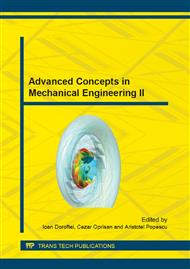p.211
p.217
p.223
p.231
p.237
p.243
p.250
p.256
p.262
Researches on the Behavior of the Supporting Structure of Railway Traction Vehicles under the Effect of Shock Dynamic Forces
Abstract:
During circulation the railway vehicle is subjected to the action of dynamic forces under the effect of shocks that appear in the driving system caused by stick slip phenomenon, dynamic forces arising from the rolling process when the wheelset is passing over accidental vertical unevenness of the track and also longitudinal dynamic forces occurring in the case of buffering, respectively those caused by frontal impact (the crash forces). The present paper presents the mechanical and mathematical models which are underlying the evaluation of the magnitude of these forces as well as their effects on the resistance of supporting structure of the vehicle and on traffic safety.
Info:
Periodical:
Pages:
237-242
Citation:
Online since:
October 2014
Authors:
Keywords:
Price:
Сopyright:
© 2014 Trans Tech Publications Ltd. All Rights Reserved
Share:
Citation:


